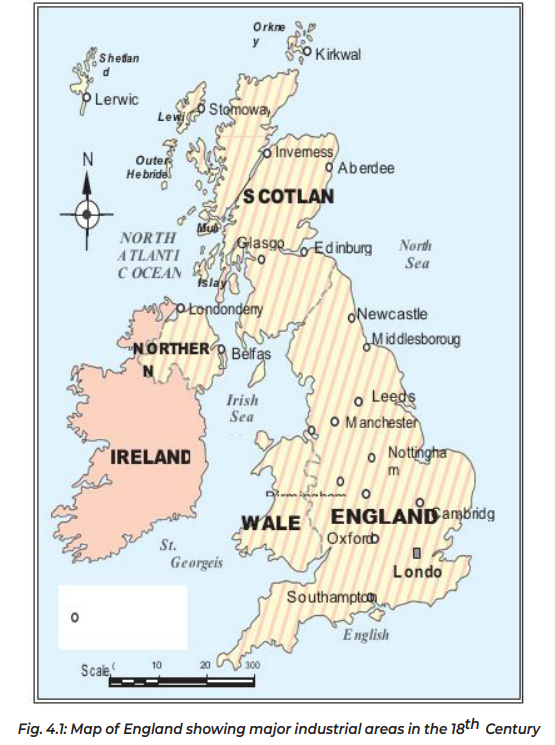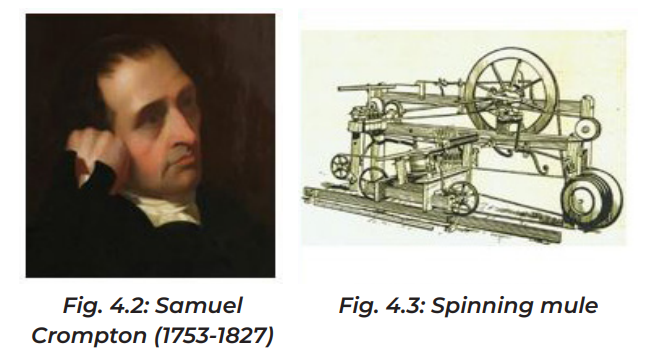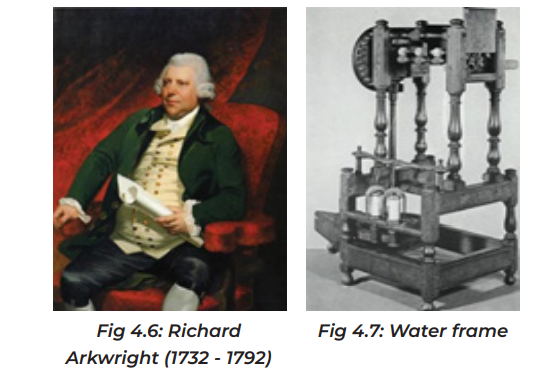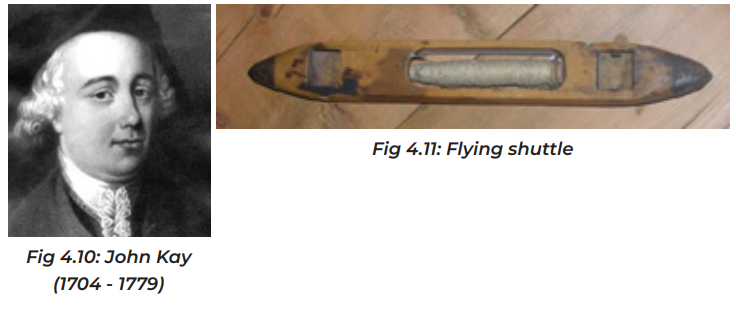UNIT 4: THE INDUSTRIAL REVOLUTION
Key unit competence: By the end of this unit, the learner should be
able to explain the causes and consequences of
the industrial revolution, technical inventions andtheir inventors.
1. Use a dictionary or Internet to find out the meanings of the

following words:i. Revolution
ii. Industry2. Use an atlas to locate England on the map of Europe.
You must have realised that revolution is a change that takes place in a
given society. The change may affect the social, political and economic
aspects of that society. It is also defined as the process that permanently
changes the state of affairs and the way of doing things.
The industrial revolution refers to the changes in the methods of
production where machines replaced human labour. It led to greater
changes in the whole economy of European countries. It began in England
in the 1850s and later spread to other countries. Before the industrial
revolution, Europeans had low standards of life, they were living in rural
areas, poverty, war, plague and poor hygiene resulted in high death rates,
clothing was made locally, they practiced subsistence farming, they usedsimple tools, among others.
4.1. Situation in England before the industrial revolution Political,economic and social
1. Use a dictionary or Internet to find out the meanings of the

following words:i. Revolution2. Use an atlas to locate England on the map of Europe
ii. Politics
iii. Economy
iv. Social
v. Industry
Use the dictionary or Internet to find out the meaning of the word
revolution again. What do you notice?
You must have realised that revolution is a change that takes place in a
given society. The change may affect the social, political and economic
aspects of that society. It is also defined as the process that permanently
changes the state of affairs and the way of doing things.
Industrial revolution refers to the changes in the methods of production
where machines replaced human labour. It led to greater changes in the
whole economy of European countries. It began in England in the 1850sand later spread to other countries.
Before the industrial revolution started, Britain was quite different from
the way it is today. Industrialisation brought with it new types of
roads, trains and many other forms of communication. All these neverexisted in Britain prior to industrialization.
Before industrial revolution began, it was very hard to keep in touch
with people in other parts of the country. News was spread by travellers or
through messengers. Goods were distributed largely within the locality in
which they were produced.In the 1750s, UK Government was a constitutional monarchy
with a parliament. However, only wealthy male landowners were
allowed to vote (about 5% of the total population). The poor had
no representation in the government and were offered little protectionfrom authorities.
Politics were based on land ownership and military honours won.
Women and ordinary men were given few rights. As a result, life was a
constant battle against famine, wicked landlords, overwork and sheerbad luck.
Majority of the people lived in the countryside. They depended on
agriculture. Subsistence farming was still very common. A family
would have a small farm which provided for their own needs, and would
sell any surplus produce. Other people would work as labourers on largercommercial farms.
In the domestic system, Britain relied on cottage industries. An example
of a cottage industry was weaving. Most weavers worked in their own
homes. Weaving was a predominantly male occupation during that
time. Women and girls did the carding and spinning of wool into thread.
The whole family was involved. Everything was powered by hand,
animals, windmills or water-wheels. This system could only produce
goods in small quantities. As manufacture was by hand, with items being
made individually, it was a slow process. With the rapidly growing
population of this period, the domestic system was not able to producethe amount of goods required.
Most people in preindustrial England lived on a subsistence level, with
little or no savings. Most peasants struggled simply to meet the basic
needs of their families. In England, between the 15th and 18th centuries,70% to 80% of household income went to buying food.
For centuries, the English diet consisted mostly of bread and porridge,
with very little meat. As a rule, Europeans ate few fruits or vegetables.
They believed that the fruits and vegetables could cause disease,
depression and flatulence. Most people were illiterate and rarely bathed.
Their idea of healthcare was that physical suffering from an illness wasGod’s divine way of purifying the soul.
Many children worked in the family farm or business. Others were
trained to either become traders or go into domestic service. If they wereservants, they would normally live in the home of their employer.
Daily life in pre-industrial times changed very little for Europeans. Almost
all people lived and worked in the countryside. Things changed from
1300 to 1750. For the average peasant, people’s work and social life mixed.
Families lived on small plots of land, growing crops mostly for home
consumption. Children learned to milk cows, churn butter and tend to
farm animals. For many years, rural families relied on tools such as woodenploughs. They also depended on beasts of burden to pull them.
Transport was mainly on foot, on horseback and in horse drawn
vehicles. People also relied on water transport by 1750. Roads were horrible.
It took over two weeks to travel from the top to the bottom of the UK
by road. People used ships (via the ocean and, later, canals) to movequickly or to transport goods but still it was slow.
The wealthy had their own horse-drawn carriages. There were also
public coaches, which often carried both mail and passengers. Ordinary
people used them. For local journeys, most people walked several milesto a town or to visit friends and relatives.
Education was variable. There was no compulsory education in England.
Children of the poor could only get a little elementary education at a charity
school or ‘dame’ school. Many children were taught to read and writeat home. Literate mothers often gave children their first lessons.
Grammar schools educated middle class boys such as the sons of
tradesmen and farmers. Private tutors and governesses sometimes
educated the children of the upper classes at home. Sometimes theywent to boarding schools.
For boys, Latin and Greek were still very important. Latin and Greek were
at the centre of grammar school and boarding school curricula. Girls’
boarding schools often concentrated on fashionable accomplishments
such as music, drawing, embroidery and French. However, some hadmore demanding curricula.
Clothing was made locally with animal hides and fur. Nylon had to be
used. Cotton was not imported in large quantities until developmentsenabled mass production of goods.
Another clear trend in pre-industrial society was the slow growth
of population from generation to generation. Poverty, war, plague
and poor hygiene resulted in high death rates, especially among young
people. Even in the 1600s, approximately 25% of newborn children died
before their first birthday. Another 25% died before their tenth birthday.
Life was for the bulk of the population, the farmers. By the 18th Century,
the feudal system was long gone. It was replaced with a system in
which the people were as reliant upon each other and their masters asbefore.

 1. Compare modern Rwanda with England before the industrial
1. Compare modern Rwanda with England before the industrial
revolution.
2. Discuss in detail each of the following condition that existed in
pre- industrial revolution in England:
i. There was no use of fertilisers.
ii. There was no use of tractors.
iii. There was land fragmentation.
iv. Europeans were using poor tools.
v. Animals such as pigs, goats, cows and sheep were kept together.
vi. Most farmers built their houses far away from farms.
vii. There was no fencing of the land.
viii. There were no low standards of living.
ix. There was scarcity of goods.
x. All Europeans were lazy.4.2. Factors that led to the industrial revolution.

1. By using the internet or history books in school library, identify
three factors that led to the Industrial Revolution.
2. Discuss the reasons that led to the industrial revolution in
England. Present your findings to the class.
4.2.2. Factors that led to the industrial revolution in Britain.(a) Lack of internal custom barriers.
Britain had no internal custom barriers that would discourage investors
to invest in industrialisation.
(b) Political stability.
Britain had enjoyed a period of relative peace and stability unlike Germany,
Italy and France. Britain kept off from European conflicts as well.
(c) Presence of a strong naval force.Britain had a strong naval force which protected her from external attacks.
She used her navy to protect her merchants from foreign competition and
to guard her trade routes.
This was something that encouraged foreign investors to invest theirmoney in the industrial sector.
(d) Improved transport system.
This included roads, railways and water transport which were much
developed. Canals were constructed linking existing rivers and lakes.
During the second half of the 18th century, roads and railways were
constructed to link industrial centres. They were to transport raw materials
and finished products to their destinations as well. It eased connectivity
in terms of sources of raw materials, transportation of workers, industrialcentres and markets.
(e) Favourable government policy.
The government of Britain lowered taxes on profits to support the businessclass. This also encouraged industrialisation to take place.
(f) The impact of the 1789 French Revolution and Napoleonic wars.
This discouraged industrialisation in France. On the other hand, itmotivated Britain to industrialise and supply France with industrial goods.
(g) Existence of natural harbours.
Britain had good natural harbours which could not freeze even in winter.
This facilitated the transportation of goods throughout the year.
Good geographical location of Britain.
Britain was located at the centre of less industrialised states that provided
market for her finished goods. She also had navigable rivers such as
Thames. All these were instrumental for the beginning of the industrial
revolution.(i) Dominant position on over sea trade.
Britain controlled a big part of Europe’s overseas trade mostly in the 18th
Century. This helped her get cheap raw materials to feed her industries.She also got a market for her finished goods\
1. Identify the factors that led to the industrial revolution in Europe.

2. Listen to your teacher as he/she reads for you some more points
on Industrial Revolution. Point out the key elements which led toIndustrial Revolution .

4.3. Effects of the industrial revolution
1. Discuss the effects resulting from industrial growth.

2. Present the findings.
The following were some of the effects of the industrial revolution:• New machines which were used led to unemployment of many
people.
• There was expansion of international trade as countries produced
different goods.
• Industrialisation led to the need of market and raw materials from
Africa and subsequent colonisation of Africa.
• It led to the development of modern transport and communication
systems. Many roads, railway lines, bridges and canals were
constructed during this period.
• It led to increased utilisation of idle natural resources that were not in
use before.
• The industrial revolution led to urbanisation, that is, urban centres
developed due industrial activities.
• The industrial revolution increased the demand for services provided
by lodges, hotels, banks, insurance companies and schools.
• It led to the collapse of feudalism in Europe. This was because
landlords sold their land to the members of the middle class.
• It helped the middle class to get political power. This later promoted
democratic rule in Europe. People could now vote for leaders of theirown choice.
• The industrial revolution led to the rise of socialism. People advocated
for state ownership of property to replace private ownership and income
inequality.
• It increased the number of middle classes for these owned factories
and mines. Some started sending their children to upper class
schools.
• It led to rural-urban migration leading to overcrowding and
accommodation in towns.
• The fumes from industrial centres led to environmental degradation.
The industries produced bad smell leading to air pollution.
• It led to the increase in population in Europe. Population in many
European countries tripled due to better living conditions. There was
good shelter as well as improved medical care that reduced diseases
that previously killed people.
• The industrial revolution led to exploitation of workers by industrial
owners. People worked for long hours with low wages. There were
cases of unfair dismissals which contributed to the formation of trade
unions. The trade unions bargained for better working conditions.
• It increased child labour in mines and mills in England. Child labour
was the cheapest labour of all.
• Industrial accidents increased. The infant factories were extremely
unsafe. People worked without safety regulations and with
no protective gears in place. In case of injuries, there was no
compensation.

 4.4. Factors for the formation of Trade Unions1. Draw a table with two columns showing both the positive andnegative effects of the industrial revolution from the above points.Share your work with your classmates.2. Present your findings to the class.
4.4. Factors for the formation of Trade Unions1. Draw a table with two columns showing both the positive andnegative effects of the industrial revolution from the above points.Share your work with your classmates.2. Present your findings to the class.
Research on the internet the meaning of trade union. Present yourfindings.
A trade union, also known as a labor union, is an organized association of
workers in a particular trade, industry, or profession who join together to
promote and protect the rights, welfare, and working conditions of theirmembers.
The following factors contributed to the emergence of trade unions
during the industrial revolution:i. Poor working conditions: The rapid industrialization led to harsh
working conditions in factories, including long hours, low wages,
unsafe environments, work accidents, poor accommodation,
absence of holidays, and illegal dismissal. Workers faced exploitation
by factory owners, leading to dissatisfaction and a desire forcollective action to improve their working conditions.
ii. Low wages: Factory workers often received low wages that were
insufficient to meet their basic needs. The economic hardship faced
by workers served as a catalyst for the formation of trade unions to
negotiate for better pay and improved working conditions.
iii. Lack of workers’ rights: There were minimal legal protections for
workers, such as the absence of labor laws, lack of sick leaves, lack
of health insurance, among others. Trade unions emerged as a
response to this lack of protection, advocating for workers’ rights
and legal reforms.
iv. Job insecurity: Industrial workers faced job insecurity. Trade unions
provided a means for workers to collectively address issues of job
security and employment stability.
v. Political and social movements: The emergence of political
and social movements, including socialist and labor movements,
contributed to the formation of trade unions. These movements
advocated for workers’ rights and promoted the idea of collective
action to address economic and social inequalities.
vi. Technological changes: Advances in technology during the
the industrial revolution often resulted in the displacement of
skilled workers by machines. This displacement created a sense
of insecurity among workers, motivating them to organize andprotect their interests collectively.

Research more information about the factors that led to formation oftrade unions.
4.5. Technical inventions and their inventors.
1. Research on the developments made during the Neolithic
revolution. Use internet and other History resources.
2. Relate those developments with technical inventions during the
industrial revolution.
Let us now briefly discuss the following technical inventions and
their inventors:i. Spinning mule (Crompton’s mule) by Samuel Cromptoni) Spinning mule (Crompton’s mule) by Samuel Crompton. Spinning
ii. Spinning jenny by James Hargreaves
iii. Water frame by Richard Arkwright
iv. Steam engine by James Wattv. Flying shuttle by John Kay
mule is a machine used to spin cotton and other fibres. It was
invented in 1779 by Samuel Crompton. He combined both the spinning
jenny and the water frame to create this machine. It is also known as
Crompton’s Mule. The machine was widely used between late 18thCentury and 20th Century.
ii) Spinning jenny by James Hargreaves. In 1764, James Hargreaves
invented the Spinning jenny. It was a device which allowed one person
to spin many threads at once. It helped in increasing the amount
of finished cotton that a worker could produce. By turning a single
wheel, one could now spin eight threads at once, a number that was
later increased to eighty. Unfortunately, the thread was usually coarse
and lacked strength. Despite this shortcoming, over 20,000 machineswere in use in Britain by 1778.
iii) Water frame by Richard Arkwright. In 1764, Richard Arkwright
created the Water frame to produce yarn faster. It was initially called
the Spinning frame. It was too large to be operated by hand. After
experimenting with other sources of power, Richard Arkwright
decided to employ the power of a water wheel. His machine came tobe known as the Water frame.
iv) Steam engine by James Watt. In 1769, James Watt improved the
steam engine and in effect created a new source of power. Early model
steam engines were introduced to drain water and raise coal from
the mines. The crucial development was the use of steam for power.
The first steam engine was actually produced by Thomas Newcomen.
James Watt later improved and patented it. The original idea was to
put a vertical piston and a cylinder at the end of a pump handle. The
next step was to put steam in the cylinder and condense it with a spray
of cold water. The vacuum created allowed atmospheric pressure to
push the piston down. Watt made it a reciprocating engine, creatingthe true steam engine.
v) Flying shuttle by John Kay. Flying shuttle was a machine used in
weaving. John Kay, a mechanic from Lancashire, patented the flying
shuttle. Using cords attached to a picking peg, a single weaver, using
one hand, could operate the shuttle on the loom. With this invention,
it took four spinners to keep up with one cotton loom, and ten people
to prepare yarn for one weaver. So, while spinners were often busy,
weavers often waited for yarn. As such, the flying shuttle effectively
doubled a weaver’s production of cloth.
Other inventions are:
• Grame discovers in 1869 the Dynamo.
• The American, Samuel Mors, invents the telegraph.
• The American Thomas Edison invents the first lamp.• The Italian Marconi and the French Branly invent the radio.
• The American Bell invents the telephone in 1876.
• The German Roentgen discover in 1896 the phenomenon which
allows one to see across an opaque body and there was born the
radiography.
• Louis Pasteur discovers that the microbes are small living beings
which are the basis for the fermentation of beer and milk. He
succeeded in manufacturing a vaccine against rabies, cholera.
• The English man, Davy, discovers aspirin.
• The English man, Harroy discovers the circulation of blood.
• The Russian Mendeleev establishes a classification of all chemical
elements Re-covering of roads by John Macadam
• The locomotive was invented by Georges Stephenson
• The railway develops first in England then in the whole of Europe
and in America, hence the transportation of many commodities.
• There was mechanization of agriculture through the use of tractors.
• Chemical fertilizers replace natural fertilizers.
• The postal services begin in 1840 and deal with the transmission of mail.
Remember: Industrialisation is of value to a country’s economy. It enables
people to get employment. It also ensures that there is provision of
affordable products of acceptable standards. The government too
gets taxes. However, the industrial wastes and gases from industries
should be well managed. Good management of the wastes reducesenvironmental degradation. We will also have good health.
Research on internet other inventions and their inventors after 19th
century.
 1. Define the term ‘the industrial revolution’.
1. Define the term ‘the industrial revolution’.
2. Describe the factors that led to the industrial revolution in England.
3. Assess the effects of the industrial revolution.
4. Briefly explain some of the technical inventions and theirinventors during the industrial revolution.
